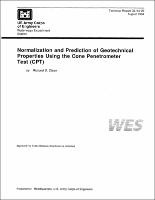Please use this identifier to cite or link to this item:
https://hdl.handle.net/11681/13062| Title: | Normalization and prediction of geotechnical properties using the cone penetrometer test (CPT) |
| Authors: | University of California, Berkeley Olsen, R. S. (Richard S.) |
| Keywords: | Geotechnical properties Sand friction angles Soil strength Soil mechanics Stress exponent Stress normalization Soil testing Soil tests Cone Penemeter Test |
| Publisher: | Geotechnical Laboratory (U.S.) Engineer Research and Development Center (U.S.) |
| Series/Report no.: | Technical report (U.S. Army Engineer Waterways Experiment Station) ; GL-94-29. |
| Description: | Technical Report Abstract: This research was to develop techniques for (1.) stress normalization of CPT measurements (and geotechnical properties) and (2.) CPT prediction of geotechnical properties using cone and sleeve friction resistance values. Stress normalization allows a variable geotechnical property to be reduced to an equivalent value at a standard confining stress. A new concept, the Stress Focus, was identified which provides a basis for understanding soil strength as a function of confining stress. This study demonstrated that sand friction angles for different initial relative densities converge to a Stress Focus at high confining stress (approximately 100 am), where the strength behavior is similar to that of a sedimentary rock. Dilation of dense sands decreases with increased confining stress until the Stress Focus is reached, as confirmed using historic high pressure triaxial test data as well with CPT measurements from laboratory chamber tests and uniform soil layers. The paths of convergence to the Stress Focus are exponentially related to confining stress and are the basis for development of CPT cone and sleeve friction resistance normalization techniques. The overburden stress at the Stress Focus is soil type dependent. The stress exponent for SPT normalization was shown to be equal to the CPT derived stress exponent. CPT correlations to geotechnical properties were established using both CPT cone resistance and friction ratio. These correlations were based on a large database which was developed for this research effort. Statistical evaluation during the development of these correlations concentrated on excluding biased data. CPT based correlations were established for the following geotechnical properties: SPT blow count, unconsolidated undrained triaxial test strength, field vane shear test strength, and shear wave velocity. |
| Rights: | Approved for public release; distribution is unlimited. |
| URI: | http://hdl.handle.net/11681/13062 |
| Appears in Collections: | Technical Report |
